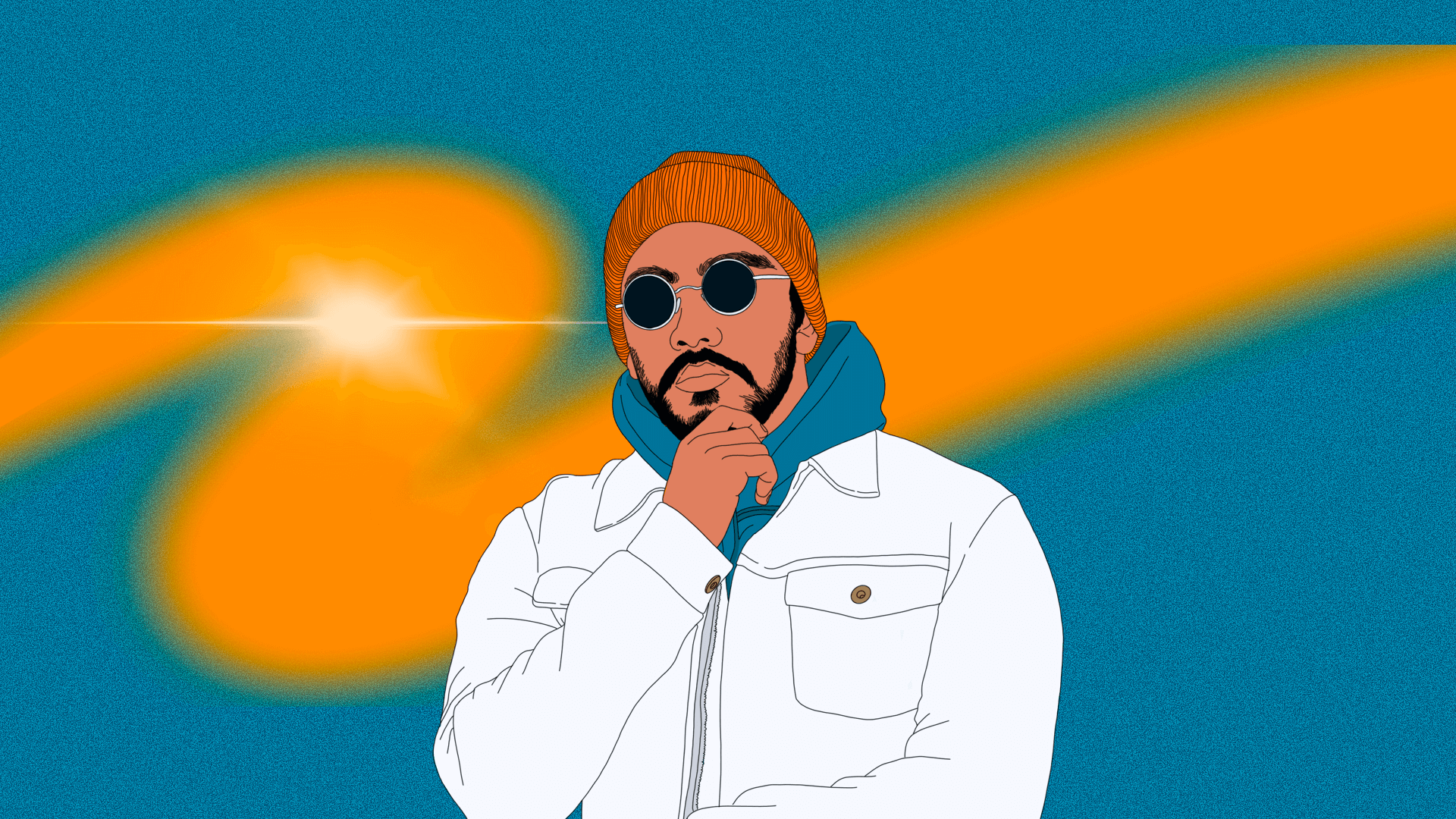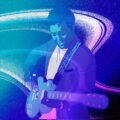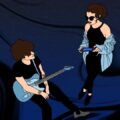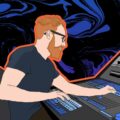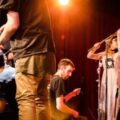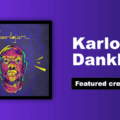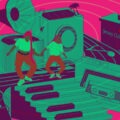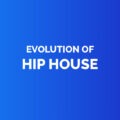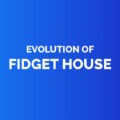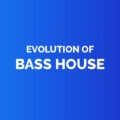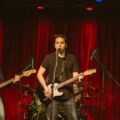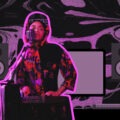RAC alum T. Chandy is perfecting the recipe for success, armed with an airtight flow and undeniable work ethic. His latest album EGO TRIP balances the bravado with astute observations on the human psyche.
Describe your music in three words:
Story, Feeling, Identity
Best way to get inspired:
Go for a walk
Favourite software:
DAW – Pro Tools
Best release of 2021:
Tyler, The Creator – Call If You’re Lost
Favourite song to sing in the shower:
Saint JHN – Sucks to Be You
T. Chandy has never been one to back down from a challenge. The Ottawa-based rapper and producer embodies the meaning of diligence, blending consistency with creativity across every self-taught skill in his expansive portfolio.
Taking motivation from industry innovators like Kendrick and Kanye, T. Chandy’s artistic vision continues to sharpen as he builds his brand of hip-hop finesse. His newest release, EGO TRIP, elevates his trademark flow and polished beats with sharp commentary on the manifestations of ego in our society. Every layer to the project reaffirms that T. Chandy is one to watch – a contemplative creative guided by steadfast craftsmanship and a hunger to change the game.
RAC recently caught up with the versatile alum to dive into the world of EGO TRIP and unpack his greatest philosophies for artistic flourishing.
RAC: Thanks for sitting down with us! Let’s start with the basics: tell us more about who you are, where you come from, and how T. Chandy came to be.
T. Chandy: I was born in Sri Lanka, but we moved to Canada as refugees when I was barely a year old due to the civil war. Growing up, I was mostly around Sri Lankan people, as the refugees who moved to Canada created their own community (so Sinhala is technically my first language). My mom was very adamant about me excelling in reading, writing and speaking English. She would always give me extra work at home and put me into short story competitions as well as the library’s summer reading program. Neither of my parents were fond of us watching a lot of TV or playing video games, especially since we couldn’t really afford it, so they limited my screen time. However, they gave me an MP3 that I was allowed to use whenever I wanted – that’s really what changed everything for me.
When I found rap, it was kind of like a bunch of puzzle pieces clicked together. It was like my love of writing and stories was put into music. I’d load up that MP3 with a bunch of songs and just listen to it for hours on end; that’s when I started writing my own raps and formulating song ideas. I would print out pages upon pages of rap lyrics and study how my favourite artists would write their rhyme schemes, how they structured wordplay, and how they would tell stories through rhyme. When I look back on growing up, I really appreciate the fact that my parents never censored my music taste. They were fully aware of the explicit language, but they allowed it, after making it clear that I could listen to the music as long as I didn’t use the language in my everyday life.
RAC: Who were your earliest musical influences and how have those changed over time?
T. Chandy: The first ever rap song I heard was probably Lil Wayne’s “A Milli” – my buddy played it to me on an old iPod on the way to school – but it was Eminem’s album Recovery that came out a couple years later that got me hooked on the genre as a whole.
From there, I revisited Wayne and lived through the YMCMB movement. Tech N9ne and Hopsin really inspired my skills for lyricism. The big push in my love for conceptual writing and storytelling came from J. Cole & Kendrick Lamar. I then began to appreciate the song structure and musicality more, which got me into a lot more of OutKast, Kanye West and Pharrell.
An influence that will probably surprise a lot of people is Jon Bellion. He single-handedly inspired me to get into music production with his “Making Of” series on YouTube. He was one of the first artists that I saw who really showed the process of creating a song from top to bottom. On top of that, watching him evolve as an artist with every project is very inspiring. I mean, the man has both Quincy Jones and Piccolo on the same album!
Understanding the artist mindset has also impacted me a lot.. Artists like Nipsey Hussle, Russ, & Kevin Gates really inspire me through their creativity, work ethic, and DIY nature. Of course, I love their music, but I also really admire and identify with building something yourself out of sheer willpower and desire.
RAC: From rapping to producing, editing videos to visuals, you have established yourself as a multi-talented creative. What inspired this strong sense of versatility, and what have you learned along the way?
T. Chandy: For me, creation has always been a DIY project. Everything came down to wanting to create something and figuring out how to do it. Watching YouTube skits in elementary got me shooting my own with the family camera and editing on Windows Movie Maker. I had no idea how to mix, master, or even engineer my own songs. It started with a $15 Skype mic and Audacity, and over the course of the last 8 years it was one small step after another.
Along the journey, I also began to realize that depending on people who don’t have the same vision as you can lead to stagnation. On top of that, spending money to procure services creates a bottleneck, because you can only create in parallel to how much you can spend. Doing it all myself was really a means to an end. I never thought too deeply into it, until one day I looked up and realized I had developed a bunch of different skills that made me a Swiss Army knife.
I’ve learned to live by a growth mindset – that even if I don’t know or can’t do something, I’m only a couple failures away from being able to do it myself. The time it takes me to become good at something really depends on how quickly I’m willing to fail, and in the shortest period possible. I believe that self-sufficiency will become the new business model for artists over the next decade, as technology and information become more and more accessible.
RAC: You have lent your sound to numerous collaborations, including those with fellow members of the SURF (Seek Under Radio Flow) Collective. What role has collaboration played in your artistic growth?
T. Chandy: I think that collaborating with people was the key to unlocking my exponential growth. Every time you work with someone, you can learn so much; whether it’s a new hotkey, a mixing trick, or music theory, the little inches add up to a foot and, the next thing you know, you’re yards ahead of the competition.
For me personally, when I became serious about learning to produce, I was living with my good friend and fellow producer Delaad (who I believe to be one of the most musically-inclined people I know). Bringing him a new beat every day and getting critical feedback on it sped up my learning process and progression tenfold.
Collaborating also makes you create things you may not have otherwise considered. Over the summer I released a track with Kar33m, who is an Afrobeat artist, called “Runaway.” While I knew the song was a vibe, I did not think that it would become as big as it has. That song has now brought me new eyes and ears, and I am forever grateful for the opportunity to hop on that track.
RAC: You’ve previously described a duality to the meaning of EGO TRIP – an internal preoccupation with both confidence and doubt, but with the self all the same. How did this inspiration first surface for you?
T. Chandy: I’d been toying with the conceptual nature of the ego for a couple months before I even started making songs for the album. I thought there were a lot of avenues where the idea could be taken, and a bunch of stories that could be told both from my experiences and others. It was something that I could really flesh out over the course of a collection of songs, similar to the theme of karma on my debut project Theory Of Karma. It was only once I had finished the first 3 songs (“Spin Cycle”, “Wait A Minute”, & “Clark Kent”) that I came to the title EGO TRIP. I felt like it really encapsulated the ideas of all 3 of these songs and soon it became the thread for the entire album.
“Clark Kent” is like the personification of what we normally think when we say “ego” – confident, boastful, prideful. “Wait A Minute” is a double-edged sword; it seems like a love song, but underneath the surface it’s actually a song about addiction. “Trip” is a term often used to describe a high. “Spin Cycle” is like the combination of the two terms, ego and trip. The track is a social commentary on people today – how mass media is programming our thoughts, overly expressing the bad and making us anxious, feeding into the dark, and self-pitying side of the ego. And we keep coming back for more, we just can’t seem to turn it off.
These three tracks really helped define the direction I was taking, and then it was just a matter of filling out the blanks with whatever else I wanted to talk about.
RAC: Thematically, EGO TRIP packs a hard punch, touching on themes that range from petty gossip to the throes of addiction. Describe your perspective on music’s ability to communicate a deeper message.
T. Chandy: Music is like putting medicine in the candy, and it’s been like that for thousands of years. Whether that be songs of protest and liberation, heritage, or personal experiences – there is something about a message put to music that really affects us as humans. These connections are what compel us to feel empathy and compassion for one another. Of course, there’s music that is just for the vibe and amusement, but the music that is the most powerful connects with something much deeper.
For example, songs like “Wait A Minute” and “West End” sound very light-hearted and upbeat, but when you peel back some layers, you really begin to see the true message behind the track. Presenting the songs in this manner allows it to reach more people and be played more often, really fulfilling the “medicine in the candy” analogy.
Music is one of the only things I know that can completely alter your mood in a couple of minutes. It can give you courage in a dire situation, it can push you to do those last couple reps while exercising, and it can make you feel happier when you are in a bad mood. This is all through the message that these songs can communicate. Though I may do it with my lyrics, others do it with instrumentation or melody. “Clark Kent” is a perfect example of this. The goal of that track was to pump you up, get you hyped, feeling like you could take on the whole world – and every time it drops, I want the listener to feel goosebumps.
RAC: Tell us more about the creative process involved in making EGO TRIP. How did you structure your creativity?
T. Chandy: I try to make music everyday, because you never know when you might create the song that changes your life. For me it’s all about creating, creating, creating until you find the needle in the haystack. After I came to a decision of what I wanted the album to be about, it was full steam ahead.
I think that, as artists, we have a certain sense of “knowing” what we are looking for even if we cannot specifically explain it. For me, once I had clarity of where I was going, I just kept making beats everyday and thinking of song concepts. I probably made 20 or 30 song ideas that had nothing to do with the album I was trying to create, but I would see them through – I knew that though it may not have been what I was looking for, I could come back to those songs in the future. The effort made it that much sweeter when I had chiseled away and made the perfect 7 tracks to tell the story I was trying to convey.
RAC: How do you pull yourself out of an artistic rut? What words of advice do you have for other artists on maintaining a creative output?
T. Chandy: For me, it’s all about momentum and building habits. I try to make sure I create as much as possible, regardless of whether or not I am in the mood. I started doing this when I remembered that there have been days where I’ve forced myself to go to work, even when I didn’t want to, just because I wanted to make the money.
My “why” as an artist is the desire to become the best version of myself that I can be, and to create the best music that I can possibly make. The only way that will be possible is through consistency and progression – by working at it, even when I’m in a creative rut. That would be my advice to artists: keep creating because you can always undo, edit or delete, but you need something on that canvas to do so.
RAC: What have been the biggest takeaways from your education in music production?
T. Chandy: The biggest takeaway for me was that the world is in a state of constant change, and the music industry is no different. What’s in fashion today might be gone tomorrow, but it might also come back 20 years later. Every rule in the book is being broken, and that’s accepted because that helps to push the art form forward. All this to say: no matter how experienced or skilled you are, nobody really knows what they’re doing, and no one really knows what the next biggest hit is. Just be yourself, create what you want to create, and be ready for change.
RAC: Thanks so much for your time, T. Chandy! How are you rounding out the year, and what are your goals for 2022?
T. Chandy: I do have at least one more release scheduled for 2021. The next one is a single that I’ll be releasing later this month, featuring another Ottawa artist named Banggz. We also shot a music video for it, so keep your eyes peeled, because this one’s gonna be my best one yet!
As for 2022, I still plan on dropping singles consistently, every month or so. However, I will be focusing more on the visual aspects of everything. You’ll be getting a little taste of this with the next release [with Banggz]. I also plan on collaborating with other artists – not only with features, I also want to increase my production catalogue and produce for others.
Written by Rebecca Judd
Illustration by Malaika Astorga
